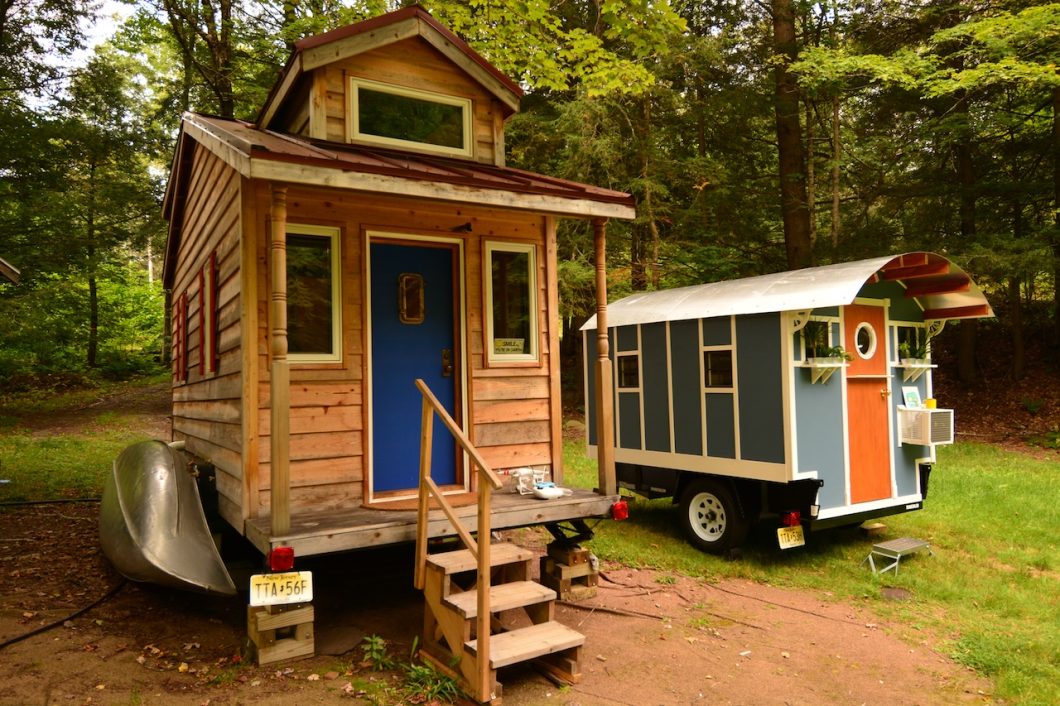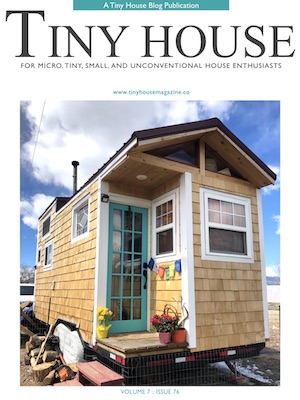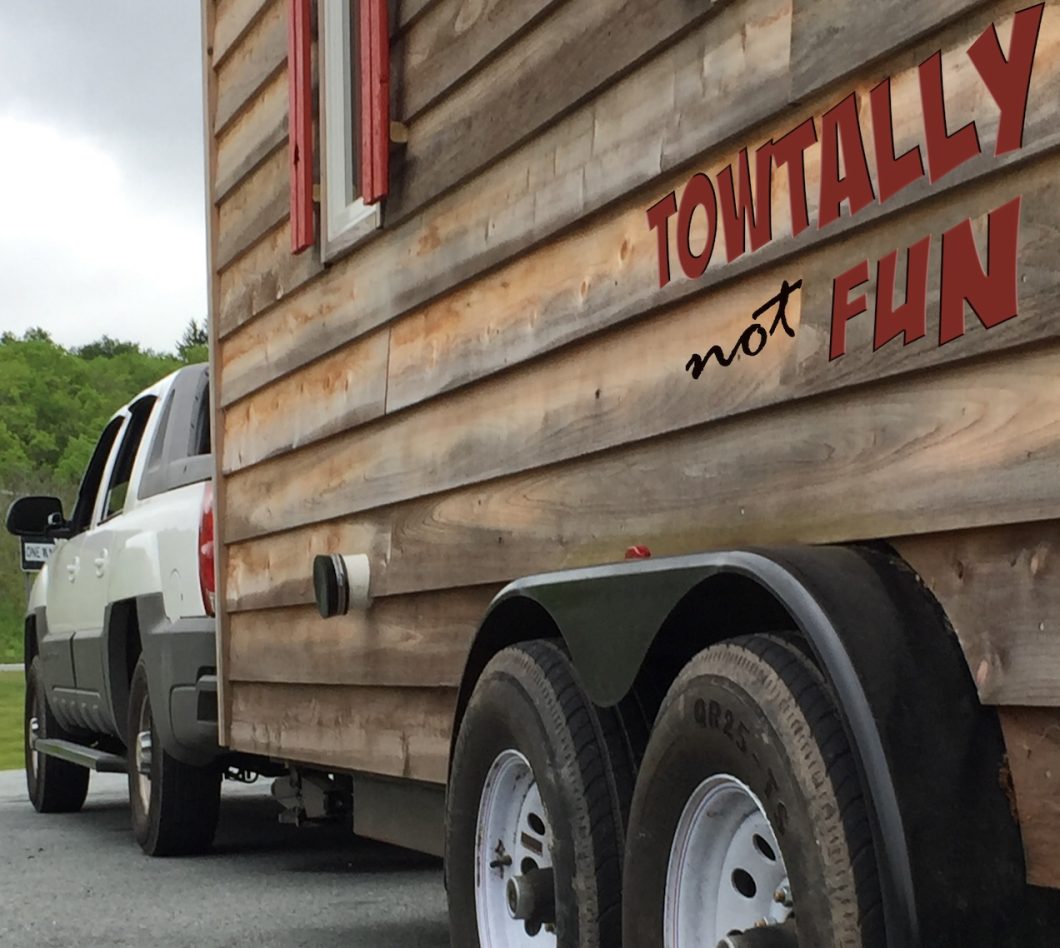Everybody loves tiny houses.
They enjoy broad appeal. There’s been a ton of TV shows about them, and people naturally gravitate towards a small, cozy space. Folks like the notion of having a house to meet their exact needs, and they love the idea of it being on wheels and being able to be mobile with it.
Well, here’s the thing that I want to focus in on. Leading a nomadic existence with a tiny house is extremely difficult. I’ll let that sink in for a moment. We’re easily lead to believe that structures that have wheels are naturally movable and beckon to be taken to places far and wide. And, yes, that’s all true with tiny houses. They can be and are moved around a fair deal. Doing so isn’t always what people imagine it is and I want to spend a little time to dispel some preconceived notions around tiny house mobility.
My name is Chris Schapdick. I run a company called Tiny Industrial based out in New Jersey. I build tiny houses and write books about living small.
I get a lot of people who ask me questions about the tiny houses I build. The question that I get most often centers around the weight of the structure and ability to tow. This topic comes up over and over.
In general and broad terms, tiny houses are extremely heavy and not particularly easy to pull.
I happen to build comparatively small tiny homes and specialize in shepherd huts and vardos. The largest house that I make is “The Oculus”. It’s a 16-foot, shed roof, single level tiny house.
When completed, that particular house weighs in at a hefty, 6,000 pounds although it’s only 16 feet long and 10 feet high. For the size of the tiny house, that’s not particularly unusual. If you were to compare that house with, let’s say a manufactured camper of similar size, the camper is always going to be significantly lighter.
In part that is where some of this confusion comes from. People see campers on the road all the time. People see folks towing campers with cars and small trucks. I’m here to tell you that tiny houses are a very different beast.

Campers are manufactured to be exceptionally light.
They’re made with the expectation that people are not looking to live in them full time. They are a summer recreational vehicle for weekend getaways. To that end, they are put together with a minimum of insulation, single pane windows and built as large and light as possible. That’s one of the reasons why campers are both affordable and, generally, you’re getting a lot of square footage for your money. Contrast that to tiny houses, and they are going to be more expensive, and they’re going to be heavier.
Why is this? Because we’re not talking about a camper anymore, we’re talking about a house. Creating and building a house using traditional stick frame construction (2x4s and such). We’re making a solid, well-insulated, well-crafted structure that is very much capable of being towed down the road. But to get the longevity, to get the high R-values in the walls, to get the comfort in the house and to include all the various features that people want in their tiny houses, it does ratchet up the weight very quickly and considerably.
Let’s get back to the micro homes that I build. When people do reach out, one of the most popular questions is, can I tow it with my such-and-such car? The answer 90 percent of the time is “no” because again, this comes back to preconceived notions of what it takes to tow even a small custom-built structure. I get a lot of questions for people who have a Prius, Subaru, and so on. For some reason that seems to be a popular car option that people have.
These are great cars but, keep in mind that we are now talking about towing a small tiny house. Something that weighs in at ~2000lb. That is very small on the tiny house spectrum. We’re talking about 40 or 50 square feet of space. I consider that to be a custom RV or similar and something that you can travel around with.
With that said, you still need a big car, small SUV, or small truck to tow even the smallest tiny houses.
What does all this mean? Well, it means that you have to be willing to accept some trade-offs. And, one of the key questions that you have to come to grips with and answer for yourself is “How much traveling am I going to do in this house?” If your goal for going with a tiny house or building or having a tiny house built for you is to travel the country and see 48 states, then you’re going to have to shift your focus, to the smaller end of the weight and size spectrum.
You can tow larger houses around. Alexis and Christian of Tiny House Expedition, have done so very successfully. They’ve towed a reasonably large and heavy tiny home for tens of thousands of miles behind a Uhaul truck. And, that’s worked out fine for them. That is because they set out to do that and they had the tow vehicle available to do that. When you budget, and you plan, and you build a tiny house, a lot of the time people aren’t thinking about the tow vehicle aspect. If you’re not thinking about towing, it will come up eventually. I hate to see when people start down that path of planning out their tiny house without having considered what it’s going to take to tow the tiny house.

You don’t necessarily have to be the person that winds up towing it. There are plenty of trucking services out there which will move your tiny house around for you. That doesn’t really sync up well with this notion of a nomadic lifestyle. If you want a nomadic lifestyle, go very small. If you want a tiny house that’s going to be moved, occasionally, perhaps based on the nature of the work that you do or just based on perhaps seasonal temperature changes, that would require only a minimum level of mobility.
Let’s put some numbers around this.
Your average tiny house likely is 150-250 square feet, close to the maximum height (13’6″), standard width (8′ 6”). That type of home is going to come in weight-wise at anywhere between 8,000 and 14,000 pounds, varying lengths, lengths starting at 20 to 26 feet in length, double axle trailer. That is very heavy.
For the most part, that type of house can only be towed by a large truck. By “large truck,” I mean a dually diesel truck. That’s your best bet for pulling a house like that. When I go to tiny house shows to exhibit my “Tiny Industrial” brand houses, I always notice that at the show itself you see a whole bunch of tiny houses, but what you don’t see is the parking lot somewhere next to the event venue that is parked full of big diesel trucks. These are the trucks that have brought those houses to that particular venue. I feel like the attendees to these shows don’t often see that aspect of it because the trucks are parked off-site.
They see the house, and they don’t see the trucks. This helps perpetuate this notion that these tiny houses magically and effortlessly move around. They do not, and large diesel trucks are costly. So, if you’re looking to spend $40,000 to $60,000 on a tiny house that’s of the size that I just described, you’re going to need a truck that costs the same amount as the house to be able to tow that house anywhere.

Towing is not a very fun activity either.
I tow things all the time. I don’t enjoy it because the bottom line is you have a very heavy object behind your tow vehicle. It’s a high object that offers up a lot of wind resistance. When trucks are passing you there is a lot of wind pressure on the house, and it causes you to have to counter that pressure with nimble minor adjustments of the steering wheel. These forces all act on your vehicle in ways that they wouldn’t if you weren’t towing something.
This feeling of enhanced vigilance is increased and ratcheted up when you are towing close to the towing capacity of your vehicle. Therefore it’s not inherently about not having a big enough truck or a big enough car; it’s the actual towing capacity of that vehicle.
And you can recreate that same, not-so-much-fun feeling in a Subaru towing a fairly small trailer because that fairly small trailer with it’s inertia acting on the Subaru makes for a similar harrowing experience as with a larger tiny house scenario with a much bigger truck. By the way, never tow more than the towing capacity of your vehicle. It’s unsafe and reckless to do so, and you are putting not only yourself at risk, but also others you share the road with.
So, towing is not fun.
That’s my subjective answer to that. If you haven’t done it, I would suggest that you borrow a neighbor’s boat or camper and you try driving around with it. It’s, not great changing lanes on the highway, taking corners with it, driving over railroad tracks.
Let’s talk about fuel consumption as well. When you have that large truck or otherwise suitable tow vehicle, you can expect your fuel consumption to go up considerably and your fuel economy to plummet. I have a relatively large truck capable of towing just upwards of 10,000 pounds. And when I tow my tiny house with that truck, my fuel consumption increases by roughly 50 percent. It’s a significant, additional consumption of fuel because again, you’re towing something heavy.

Beyond fuel consumption, there’s a lot of additional wear and tear on the tow vehicle as well.
I highly recommend if you’re going to be towing anything heavy for any distance, get a transmission cooler in your tow vehicle because keeping the transmission at a lower temperature is significantly increased by use of a transmission cooler. Things like changing the oil, doing basic upkeep and maintenance of the tow vehicle, become that much more important and critical when regularly towing heavy things with that tow vehicle.
There is another thing that people maybe don’t realize about mobility and tiny houses. When your tiny home is set up as a house, you have items on shelves and some plants sitting around, and your closet isn’t bolted shut. Keep in mind that every time you move your tiny house you have to get it “road ready”. By that, I mean, securing everything. I have a storage loft and have to pull all the things out of that storage loft.
Pictures have to come off the wall unless they are screwed on like in a $25 per night motel. I don’t move my tiny house very much for all of the reasons that I’ve just described here. If and when I do move my tiny house there is a process and procedure that takes anywhere from a half hour to an hour to get that house even ready to roll. So, this doesn’t fit in well with the nomadic notions that some people have in their heads around tiny houses.
Lately, I have been seeing how school bus conversions are gaining a lot in popularity. The reason for this all has to do with this mobility aspect that we’re talking about here. When you have a school bus, you have built-in mobility. There’s no need for an additional truck or a tow vehicle. There’s a lot of really great ways to convert a school bus into a tiny home. I’m not here to say a bus is a bus, and a house is a house. No, it’s all about whatever it is that you’re looking for and whatever it is that you’re looking to do. A nomadic lifestyle and one where you’re always going from place to place is much more doable in a bus. That’s the bottom line.
That said, some of the inherent issues that have to do with towing tiny houses are things which buses aren’t exempt from. First and foremost is the fuel consumption aspect. School buses do not get good fuel economy. And, so you’re still going to be using up a fair amount of fuel. You don’t, however, need to go out and buy yourself an expensive truck to tow a tiny house. That’s something to keep in mind.
Ultimately, what I’m getting at here is that you have to find that right balance between how much and how often you want to move around, and what size of house makes the most sense based on what you were looking to do. These are things that you have to be very clear about before you even start the planning phase of your tiny house. The notion of how much you want to move it around and how much mobility you need is going to be a big determining factor in and your overall budget for your house and your tow vehicle.
There are these massive 30-foot houses I’ve seen at tiny house shows that weigh 20,000 lb. A 20,000 lb. house! It had granite countertops on the inside. It was beautiful. But that is a house that you will hardly ever want to move. If you take that amazingly liveable 20,000-pound house with its washer, dryer, bathtub, two or three bedrooms at one end of the extreme of the spectrum, that is not a mobile house.
On the other end of the spectrum, you perhaps have maybe a small SUV, and you want to do some traveling. Well, you are going to have to focus more on owning a micro house than a tiny house because you’re looking at more of a small custom RV, which may or may not be big enough to have a shower.
You can usually fit a composting toilet into a structure like that, but there are massive trade-offs. You do not have a dishwasher in there, and you’re not doing a washer/dryer setup and that type of thing. So that’s at the other end of the spectrum. And in between those two extremes, there are a vast array of options which will determine how movable and nomadic you can ultimately be in the tiny house that you’re looking build or have built for you.

I have a book coming out in June that goes through a lot of the aspects which you need to consider. This is true whether you’re building the tiny house yourself or you’re having somebody make it for you. The house is only going to be as good as the input you provide. Ultimately you’re only going to be as happy with it based on having made the right decisions along the way. You’re never going to make all the right decisions right out of the gate. It’s just not possible. It is an excellent strategy to get most of them right though. Otherwise, this whole experience of tiny living, minimalism, and downsizing are not going to be enjoyable for you.
I hope that I have been able to highlight one aspect of this. Just know that there are other considerations that you need to ponder as well. I’m hoping that you’ll consider purchasing my book, “Living Your Tiny Dreams.” That book is currently available for preorder on Amazon and will be published in June of 2019.
For the most part, the tiny house community is a very tight-knit and helpful bunch.
I’m always happy to answer questions for people that reach out via social media (Instagram and Facebook). I’m pleased to be able to impart some knowledge on people around these various topics because I know that it’s hard to think of these things on your own.
That’s why having somebody that you can reach out to ask these questions is helpful. I invite you to do that. I encourage you to pursue your tiny house dreams. I’m certainly not here to discourage you from doing that. Tiny houses have been life-changing for me. I want you to have a good experience with it too and to be safe out there on the road. I wish you luck, keep going or take the first step.
Written by Chris Schapdick for Tiny House Magazine Issue 76

 When you’re ready here is a way you can feed more of your Tiny House obsession: Get the Tiny House Magazine delivered monthly right to your inbox for less than a collapsible mixing bowl.
When you’re ready here is a way you can feed more of your Tiny House obsession: Get the Tiny House Magazine delivered monthly right to your inbox for less than a collapsible mixing bowl.
